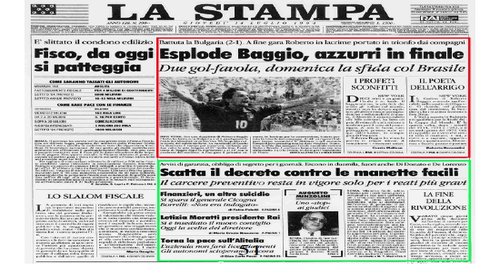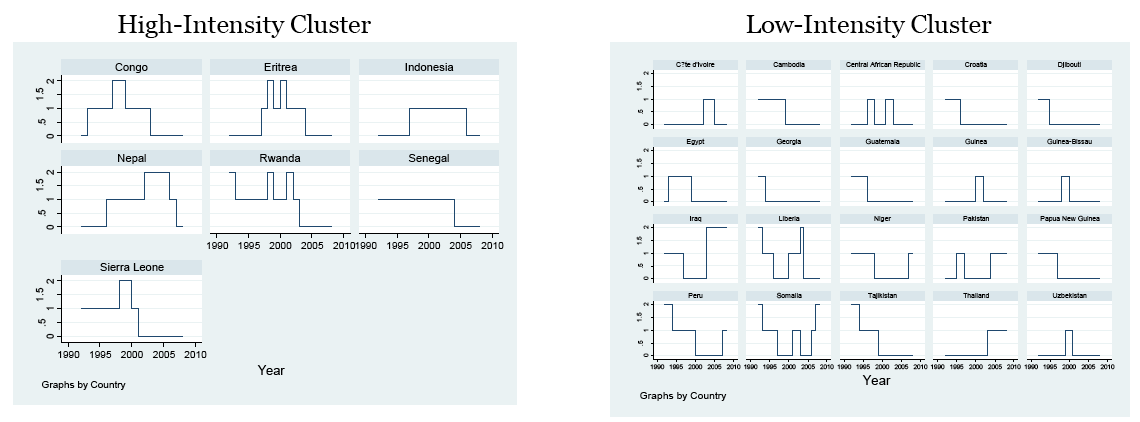Editor’s note: This post is part of a series showcasing Barcelona GSE master projects by students in the Class of 2015. The project is a required component of every master program.
Authors:
Benjamin Anderson and Ramiro Antonio Burga
Master’s Program:
Economics of Public Policy
Paper Abstract:
This paper provides empirical evidence of the persistent effects of exposure to civil conflict on political beliefs and participation. We exploit the variation in geographic incidence of conflict and birth cohorts to identify the long-term effects of exposure to violence on belief in democracy, trust in institutions, opinions in support of civil rights, voting turnout and casting of blank ballots, and participation in civic organizations. Conditional on being exposed to violence, the average person exposed to violence during certain sensitive stages of life still holds slightly more negative opinions about the value of democracy and are less likely to participate in civic / political organizations in the long-run.
Presentation Slides:
[slideshare id=53321203&doc=civil-conflict-political-beliefs-peru-150929115151-lva1-app6892]
About the paper
Motivation:
Political preferences heavily dictate the role of the government, the policy making processes that emerge, and potentially even the institutional framework, itself (Besley and Case, 2003; Aghion et al., 2004). Furthermore, consequential effects of various forms of political institutions is a primary focus of Political Economy, and justifiably so, for the array of welfare implications encompassed within, including, economic growth, inequality, health outcomes, and many others (Acemoglu et al., 2001; 2002). In countries where citizens have been exposed to violence during sensitive periods of life, it may be more difficult for governments to gain trust and build support for democratic processes and good institutions.
Pathways/mechanisms:
There are many logical pathways which one could speculate that civil conflict might affect citizens’ political beliefs; perhaps the most conspicuous of which being trust. Lack of protection, safety, and government accountability could lead to a decrease or lack of trust in the government, while exposure to violence, fear tactics, and other criminal behavior could result in distrust toward other members of society (Jaeger and Paserman, 2008; Rohner et al., 2013). Secondarily, residual effects of civil conflict in the form of fear, in particular for safety, could dissuade citizens from various forms of political participation (Salamon and Evera, 1973).
Summary of findings:
We examine the effect of exposure to conflict during sensitive developmental periods of life on persistent changes to various measures of political beliefs and participation. The results show that the average person exposed to conflict during the age range 13 to 17 will have slightly more negative opinions about democracy well over a decade after the conclusion of the violence. Very minor long-term effects are also present for participation in civic organizations. Our results show that the average person exposed to conflict during the age range of 7 to 12 has a decreased likelihood of participating in civic organizations of approximately 3% to 6% for each additional year that the individual experienced violence in his/her district during this period of life. While these effects are economically small, it is notable that any long-term effect is detected given the likely presence of strong attenuation bias as discussed in our threats to identification. We find that the most sensitive stages of life for the formation of political beliefs, with respect to exposure to conflict, are the pre-teen and teenage years. Contrary to the effects of violence exposure on human capital and labor market outcomes, we do not find effects occurring at the earliest life stages.
Inferences:
- The detection of effects in both belief and action variables not only helps to validate one another, but it also suggests that beliefs indeed translate to actions. This connection provides some evidence that changes in political perception also corresponds with political behavioral change.
- Even though the effects we detect are relatively small, they might have been severe during and shortly following the civil war.
- Although we are unable to further analyze heterogeneous effects, the effects could be quite large for certain individuals who may have been exposed to more extreme amounts or types of violent acts.
Policy Implications:
Knowledge of the size and temporality of these consequential effects of civil conflict on political beliefs and participation as well as mechanisms which drive these changes would be invaluable. This would allow policy makers to develop targeted strategies to help combat the destructive effects of violence on citizens’ political beliefs and behavior that could undermine the healthy growth, development, and stability of society.
On the experience:
The thesis was almost certainly the most fun and rewarding assignment of the year, despite the imposing time constraint. Having received rigorous training to acquire the tools needed for such a project, and having discovered and nurtured our own interests via exposure to a multitude of prominent literature in various applied topics throughout the year, it was exciting to unleash the knowledge we had gained and apply some of our empirical techniques to a new and interesting research question of our own.
Throughout the program, but especially during the thesis, we were fortunate to have access to the knowledge and support of professors. Aided by some enthusiastic and accomplished mentors, we evolved our expectations of ourselves. Their expertise in areas related to those of our paper – conflicts, violence and political economy – optimized the quality of feedback and constructive critique we received in the process. The final presentation to our directors, professors and peers was another valuable component. It served as a welcome challenge that exercised essential communication skills, not only for conveying complex ideas to an audience, but adroitly and favorably reacting to questions and criticism.
The feeling of accomplishment derived from materializing a quality piece of empirical work is great motivation to build on for the future. Just one year ago, not only would this project have been impossible to execute, even the vision of it coming together was unfathomable. By the final term, we knew that we were prepared; now, we carry forth these tools, creativity, and confidence in our abilities.
On working with a coauthor:
At the outset, the thought of working with a coauthor for the thesis did not sound ideal, but ultimately, it had many advantages. It offered another opportunity to gain from the international and cultural diversity of one another and to develop these working and personal relationships; it was an invaluable intangible experience for which we will be forever thankful. Our complimentary skillsets and working styles prevented this beast from ever becoming a burden. We are proud of what we were able to achieve given the constraints, and ended up with a final project that far surpassed anything that we could have done independently within the same amount of time.



